Tamarind of Laos: Underrated Southeast Asian Cooking School
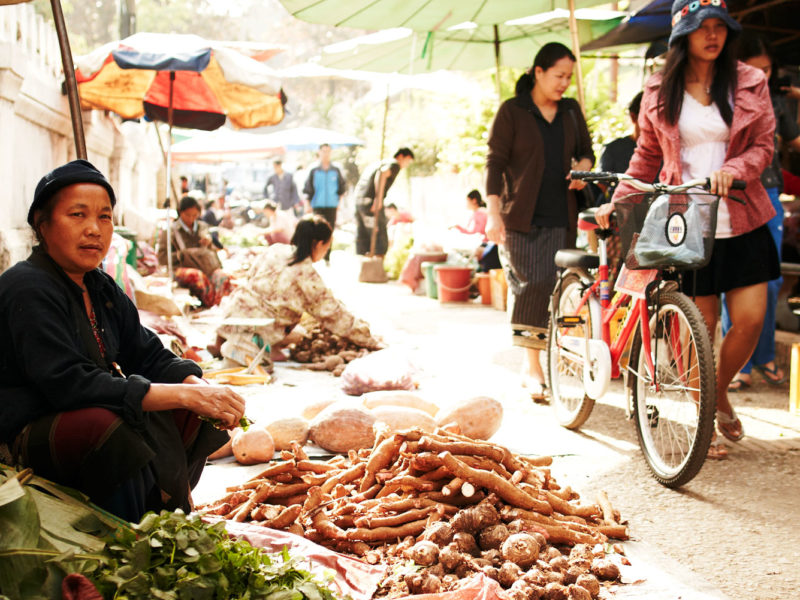

Phousi Market in Luang Prabang, Laos.
Easily the most underrated cooking school in Laos, and perhaps all of Southeast Asia, Tamarind is building a reputation for quality food and service that few in Luang Prabang can match.
Words and Images by Ewen Bell
Known as a treasure in Southeast Asia because it hasn’t been turned into a theme park for tourists, a visit to Luang Prabang is required to get a true sense of the variety in Laos cooking.
For traditional cuisine, the locals borrow very little from neighbours Thailand and Vietnam – even their preference for sticky rice diverges from the hill tribes of Thailand’s north, with rich and red gaining favour over clean and white.
However, if you want to explore the best of Laos cuisine, steer clear of the farming villages, where noodles and rice form the bulk of their diet.
Seaweed and sesame seed is a local speciality; thin filaments of algae are collected from the river where the water is shallow, rocky and oxygen-rich.
It’s pounded, flattened and fried into sheets to be sprinkled with sesame seeds and served with chilli paste. Salty and spicy, known locally as Khai Pan, this snack can be found on most good menus around town.
High on the list of regional gourmet indulgences is the kitchen at Tamarind restaurant, where genuine local treats are presented with a little class to culture-craving travellers.
Combining fresh influences from Laos with a well-managed service level has allowed Tamarind to outgrow their little café behind L’Elephant Restaurant and move a few streets down onto the banks of the Nam Khan.
The new-look Tamarind fits gracefully into the UNESCO Heritage style of old Luang Prabang, and makes the most of residential ambience on the quiet side of town.
Lemongrass stalks stuffed with chicken, spicy eggplant “jeow” served with sticky rice, and a steamed fish and curry dish called “mok pa” are typical of the menu. The lemongrass and ginger coolers are delicious too.
Local man Joy Ngeuamboupha and Caroline Gaylard – an Australian woman – are the happy couple and owners of Tamarind, and over a year ago they opened a cooking school far from the Mekong and its temples.
A former fish farm in a rural village, the site is still graced by cascading ponds and flowing water. Gardens have bloomed between the ponds and cooking classes are held in the fresh air beneath thatched roofs.
The setting is private, serene and welcoming.
To market
Each class takes most of the day and starts with the obligatory visit to the best market in town: bold and beautiful, but a little too far from the old town for casual tourists, Phousi Market is a sight most visitors to Luang Prabang won’t see – and a reminder of how genuine the local culture has remained.
Everything the local Laos want for their kitchen can be found here, some familiar, some not.
Fresh frogs, river crabs and slippery catfish fill its shaded sections. Ladies selling banana flowers are enthusiastic about having their photos taken and give a smile willingly.
One vendor sells fresh chickens, displaying each fleshy carcass alongside a tidy collection of the entrails, presented with intact yolks still attached.
Slice, bash, simmer
When we arrive at the cooking school, the key theme is mortar and pestle.
Most dishes presented by Tamarind are prepared by a process of slice, bash and simmer.
Jeow is best described as a kind of dip you get when you don’t have a blender. We toss eggplants onto hot coals to soften flesh and blacken skin, cut up a dozen herbs and mash it all into a mix.
Sticky rice becomes an eating implement: grab a ball of rice and scoop up enough spicy jeow to set your mouth on fire. Add chillies to taste – but wary visitors will start slow.
Another blend of herbs is mashed in the mortar before being applied to steaks of fresh Mekong fish, wrapped in banana leaves and left to steam while we explore other culinary concepts.
The approach here is very simple and leans heavily on the abundance of fresh produce. Balancing the ingredients with fish sauce, limes and coriander is the key to success (not to mention going easy on the chillies).
There are no gas burners: one sala is for chopping, bashing and preparing; the other has hot coals for heating steamers and roasting ingredients.
A fitting end
The finale to the savoury section is stuffing a stalk of lemongrass with chicken and a handful of herbs to enhance the flavour.
With a light touch, a section of the lemongrass can be sliced into thin strips that bend outwards like a birdcage, then you scoop in as much mixture as you can before letting it rest.
Lemongrass flavours infuse the pork before being dipped in egg and lightly fried.
After the feast, we get one last lesson in local flavours. Sticky rice with mango is a popular dish in Thailand, but in Laos they skip the white version and use a violet variety that’s very nearly black.
As you fold through coconut milk over a low heat, the colour leaches away, turning the mixture brilliant purple. Simply serve with sliced fruits and sesame seeds, assuming you have any room left after lunch.
The class finishes in the mid afternoon, and for a little under $35 you’re getting a full day of entertainment plus one of the best meals in Luang Prabang.
Given how hard it is to get into the restaurant at Tamarind, this might be a better way to sample their menu.
The details:
Where to eat
• Tamarind was once a café tucked between temples, but now has larger premises by the Nam Khan river.
Local cuisine, contemporary presentation, closed Sundays, bookings essential. tamarindlaos.com
• L’Elephant remains one of the best in Luang Prabang.
French or Laos set menus, fine dining atmosphere. elephant-restau.com
• Tamnak Lao is where you go when there’s no room at Tamarind.
Local cuisine of a high standard, just missing a little on service and presentation. tamnaklao.net
• The Night Market sees the main street closed to traffic so vendors can sell souvenirs and textiles.
A side lane opposite Phousi Hill is rampant with cheap vegetarian food and charcoal grilled meats. Bargain prices, local flavours.
Getting there
Luang Prabang is serviced by direct flights between Chiang Mai, Bangkok and Hanoi.
Vietnam Airlines and Thai International connect with Australia, while Laos Airlines links Luang Prabang with Thailand and Cambodia.
Three more great things to do in Laos
• Once known as the land of a million elephants, today the numbers in Laos are closer to 1000.
Elefant Asia sponsors the welfare of working elephants, operating forest tours to fund their work.
Travel by boat from Luang Prabang to meet your elephants, then return a week later having experienced remote villages and the ultimate in slow travel. elefantasia.org
• Local photographer Paul Wager is an ex-pat Australian who discovered Laos and lost his way home.
He offers personal workshops, knows a few remote villages and charming temples, and shares his knowledge in a personal and relaxed style. paulwager.info
• Each dawn, the monks of Luang Prabang gather outside their temples for Tak Bak, collecting morning alms.
Lined up from senior to novice, they accept food from the residents.
To maintain respect for the monks, participation requires adherence to strict rules.
Best thing about Luang Prabang
This is not a beach destination filled with rowdy backpackers; French colonial charm and ancient Buddhist temples are preserved with respect and care, and the town now attracts travellers seeking the very best of Southeast Asia.
Worst thing about Luang Prabang
The spiritual tradition of morning alms should be the highlight of any visit, but be careful to avoid the centre of town, especially in the cooler months when tourists escape the European and Chinese winters.
Busloads of over-eager visitors thrust their cameras in the way of monks and fail to show due respect.
Just walk away from the crowds and enjoy the reverence of Tak Bak in a quiet street without the more glamorous temples.
Where to stay
Accommodation abounds, with five-star hotels outside the old town and charming boutique guesthouses next door to the temples.
• Ancient Luang Prabang: Clean and tidy with a touch of Laos style to add comfort. Three star, around $70 per night. ancientluangprabang.com
• Villa Santi: On the edge of the main street action with older style luxury and good service. Four star packages from $150 per night. villasantihotel.com
• Hotel De La Paix: Tucked away in a quiet area surrounded by rice fields and farmers. Five star comfort within a short drive of the temples. hoteldelapaixlp.com
Asia’s best cooking schools
The key to a great cooking school is getting your hands dirty with yummy produce, well-spoken local chefs, and lovely surrounds.
• Luang Prabang / Laos: Bookings are essential for Tamarind Cooking School, and a minimum group size is required.
Pickup from your hotel and a visit to the market is included; beer and softdrinks are extra. tamarindlaos.com
• Guilin / China: Southern style Chinese cooking differs greatly from Cantonese and Imperial styles, with influences from ethnic minorities that link China to Southeast Asia.
In the town of Yangshuo, one cooking school is helping local girls share their recipes in a converted farmhouse surrounded by limestone karst hills. yangshuocookingschool.com
• Hanoi / Vietnam: Hidden Hanoi is relatively new and full of fun and energy. Like Tamarind and Yangshuo, there’s an Australian connection behind the scenes, combined with superior local knowledge.
Small classes and big personalities are the key, and the food is as good as anything on the streets. hiddenhanoi.com.vn
• Bangkok / Thailand: A short boat ride into the narrow khlongs of Bangkok takes you away from the bustle of the city and into the leafy gardens of Thonbury.
Amita Cooking Classes are the talk of the town for a sensational location and sumptuous Thai cuisine. amitathaicooking.com


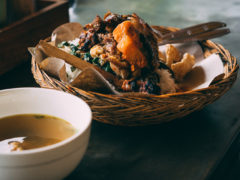
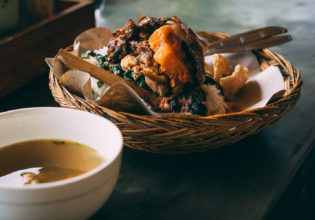

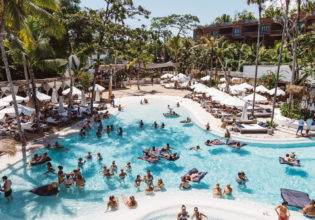
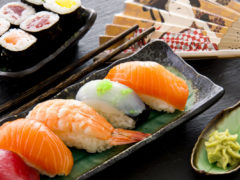
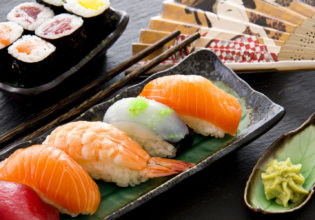


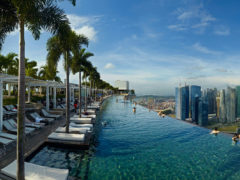


LEAVE YOUR COMMENT